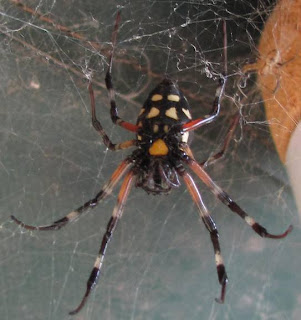In order for a
male spider to mate with a female, he must first inform her of his presence and
his intentions. He would normally do
this by tweaking and strumming on her web in a certain way that only a female
of the same species would understand.
Once he is convinced that she is aware of him he can approach her. Depending on the species, the male may then
have to perform another dance or present the female with a “gift” in order to
preoccupy her so that she does not eat him.
Others may have to use “tactile communication” – stroking the female’s
legs – to get her “in the mood”.
Once the female
is ready to mate, the male must first deposit his sperm on to the web or
substrate. He then picks up the sperm
with his pedipalps and inserts them one by one into the female’s genital
opening (epigynum). The male and female
of one species have perfect fitting reproductive organs like a lock and key, so
that two different species can never copulate.
The males of
several species of spider must retreat quickly once mating has taken place to
avoid being eaten by the female. The most famous of these are the “widow”
spiders (Latrodectus spp.), named after this behaviour. However, the males and females of many other
species cohabit amicably in the same web with no threat of cannibalism.
Araneomorph
spider females can often store up eggs and sperm and fertilize them when they
are ready. Even after they moult
(Ecdyse) they still keep the same set of eggs and sperm.
Mygalomorph
spider females, however, replace the lining of their reproductive organs every
time they moult, making them “virgins” again after each ecdysis.
Above: Latrodectus geometricus - BROWN BUTTON (WIDOW). The most famous examples of spider females eating their male partners after mating are the Widow spiders, but the males of many other species must also rush to escape the same fate. However, not all spider species practise post-sex cannibalism!

.JPG)


.JPG)

+Baboon+Spider.jpg)
+-+Baboon+Spider.JPG)
.jpg)

+(1).JPG)
+(2).JPG)
.jpg)
.JPG)


+(2).JPG)
+(3).JPG)
.jpg)






.JPG)
.JPG)
.JPG)

.JPG)

